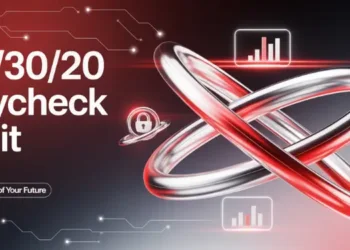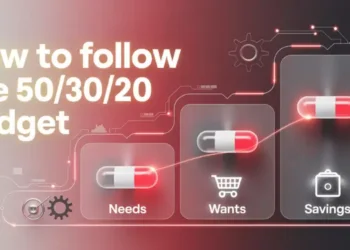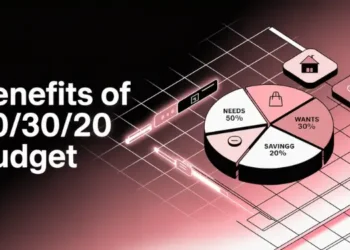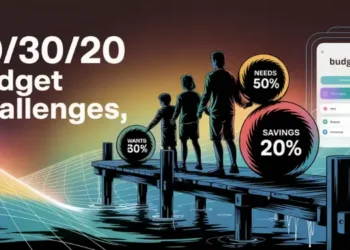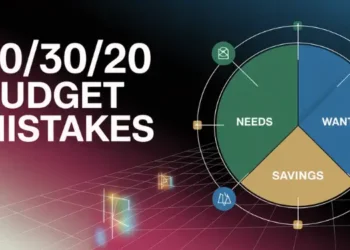Creating a 50/30/20 budget is straightforward and effective, allowing you to manage expenses with minimal tools. We’ll split your income into three parts to keep your spending steady.
Nearly 40% of American households live paycheck-to-paycheck, underscoring the stress of unmanaged finances. A Maine saver says, “Cutting expenses early can save you from big problems.” I used Percentage-Based Budgeting to pay off $80k debt quickly.
Want to learn more? Download our free 50/30/20 budget template to get started in minutes.
Key Takeaways:
- Start using Budgeting & Saving tips
- Use a budget calculator to get better
- Divide your money into three parts for control
Calculate Real Take Home Income First

We start by figuring out net income to get a clear picture. Look at your latest pay stubs, add up deductions, and estimate side income. This gives us a solid base for setting financial goals and budgeting.
Some people in Portland say it’s smart to ignore big sums like tax refunds. We focus on what we get every month. This way, we can track your monthly spending and save for emergencies. Dr. Nodin calls this step very important for keeping things stable.
Disposable income, also known as net income, is the amount remaining after federal, state, and local taxes and other mandatory deductions—such as Social Security, Medicare, and retirement contributions—are subtracted from gross earnings. Ref.: “Kenton, W. (2025). What Is Disposable Income, and Why Is It Important? Investopedia.” [!]
Pull Latest Payslips And Average Benefits
Take just five minutes to check your pay stubs. Note any health or retirement plan deductions. This helps us calculate your net income. It’s a good time to review your budget and see where we can cut back. It also helps us stay on track with our long-term goals.
Experienced savers like to follow the 50-30-20 rule. This means spending half on needs, three-tenths on wants, and two-tenths on savings. Knowing where every dollar goes helps us dream big.
Read More:
Exclude Lump Sums Like Tax Refunds
Big windfalls like tax refunds should be treated differently. They can make our income look higher than it is. It’s better to save them for important goals like paying off debt.
| Income Source | Estimated Amount ($) | Notes |
|---|---|---|
| Primary Job | 2,500 | After standard deductions |
| Side Gigs | 400 | Average of monthly earnings |
| Total Net Income | 2,900 | Used for 50-30-20 plan |
The Consumer Financial Protection Bureau recommends automatically directing a portion of tax refunds into savings or debt-payoff accounts upon receipt, helping ensure windfalls aren’t spent impulsively. Ref.: “Consumer Financial Protection Bureau. (2021). Tax time checklist: Make the most of your tax refund. CFPB.” [!]
List Monthly Expenses Before Categorizing Them

We’ll map these costs like fishing nets across a wide bay. Each line item shows a hidden weight we need to catch. Many Mainers miss hidden fees that mess up their money plans.
Knowing every cost helps us use our money better. We can save for retirement or build a savings cushion.
Try the 50/30/20 budget calculator to see your money flow. We’ll sort data into three parts. This makes it clear what to pay first and what to save.
Gather Statements To Avoid Hidden Costs
Download two months of checking account records. This shows all everyday deductions. Then, check credit cards for memberships or subscriptions.
Adobe found 60% of spenders miss recurring charges. Listing them helps us manage money better. We can keep income in three parts: bills, treats, and savings.
Consumers underestimate recurring subscription costs by an average of $133 per month, underscoring the importance of reviewing bank and credit statements for hidden charges. Ref.: “Investopedia Staff. (2025). The Easy Way To Put More Money in Your Pocket—No Side Hustle Required. Investopedia.” [!]
Mark Fixed Versus Variable Outflows Clearly

Split fixed costs, like mortgage payments, from flexible ones. This shows where we can cut to save more. It helps keep spending balanced and more money for savings.
Save some for retirement and some for fun. This way, we can enjoy life and pay off loans too.
Tip: Spend 10 minutes reviewing each expense category. This helps control spending and find balance.
Failing to distinguish fixed expenses from variable ones can lead to budget inaccuracies, since variable costs fluctuate unpredictably and require separate tracking for effective forecasting. Ref.: “PNC Financial Services Group. (2025). Fixed vs. Variable Expenses. PNC Insights.” [!]
“Explore: 50/30/20 budget basics every first time budgeter should know now“
Allocate Needs Category Using Simple Benchmarks
Imagine looking at a tidal chart at dawn to plan your day. That’s how we handle the first half of our money. We focus on the basics to keep life going.
A recent survey in Maine showed housing and utilities are big costs. So, we aim for a smart limit for these needs.
The 50/30/20 rule was popularized by U.S. Sen. Elizabeth Warren in her book “All Your Worth: The Ultimate Lifetime Money Plan,” offering a tested framework for balancing essentials, discretionary spending, and savings. Ref.: “Whiteside, E. (2024). The 50/30/20 Budget Rule Explained With Examples. Investopedia.” [!]
Cap Food, Housing, and Transportation
Put rent or mortgage, basic groceries, and essential travel in one pool. Our budgeting system puts about half your paycheck here. If costs go over, find out why and make small changes.
Small cuts can help free up money for debt repayment later.
“Check It Out: 50/30/20 budget example for a typical monthly income“
Trim Overages Wisely
Check every contract for hidden fees. Negotiate better rates for cell plans or auto coverage if needed. Use saved dollars for better things, like paying down debt.
Small efforts can help reach big goals. Try setting a timer for ten minutes to find savings today.
| Category | Recommended Share |
|---|---|
| Housing | 25% of Income |
| Food | 10% of Income |
| Transportation | 15% of Income |
Design Wants List That Feels Sustainable
Think of your monthly income as a quiet Maine harbor. It needs calm waters for savings or debt. Making a budget means deciding how much for needs and a bit for fun.
A budget helps you make choices and balance your spending. We aim to save and pay off debt while enjoying small treats. This way, you can have fun without losing focus.
Keep Subscriptions Within Set Dollar Limit
Streaming, gym memberships, and insurance are part of our lives. Cutting costs can be simple. Try sharing plans or getting better rates.
These changes give you more room without losing comfort. They also help you stay on track with big goals.
“Learn More: 50/30/20 budget breakdown separating needs wants savings without confusion for beginners“
Swap Costly Habits For Cheaper Joy
One expensive brunch can turn into a potluck. This saves money for more important things. Choosing second-hand over new gadgets also helps.
It keeps your budget flexible and avoids surprise bills. For more tips, see our guide on sticking with a 50/30/20 budget. Small changes can lead to big savings.
| Subscription | Monthly Cost | Alternative |
|---|---|---|
| Streaming Service | $15 | Share Family Plan |
| Gym Membership | $30 | Community Fitness Group |
| Music Platform | $10 | Ad-Supported Option |
Lock Savings Tenor With Automatic Transfers

Imagine money coming in like the tide. Setting aside 20% of your income after taxes is a smart move. It helps grow savings or pay off debt.
This rule works well if you divide your income into three parts. It keeps you on track with your financial goals.
Many people spend half their budget on needs. But, saving more can help achieve long-term goals. You can adjust how much you save based on your income.
Starting is easy. Just set aside a fixed amount from each paycheck. This way, you won’t forget to save.
Learn more about this method. It shows how easy it is to improve your finances with simple habits.
The Save More Tomorrow program boosted participant savings rates from 3.5% to 13.6% of income over 40 months by automating incremental contributions upon each pay raise. Ref.: “Thaler, R. H. & Benartzi, S. (2004). Save More Tomorrow: Using Behavioral Economics to Increase Employee Saving. Journal of Political Economy.” [!]
Split Paycheck Directly Into High Yield
Putting money into a high-yield account boosts growth. It keeps cash for future needs while letting you enjoy today.
Name Goal Accounts To Inspire Discipline
Giving funds a name makes saving more exciting. Naming it “Vacation” or “Next Vehicle” adds motivation. Over time, small savings add up to big rewards.
Finalize Budget In Spreadsheet Or Template
We’ve looked at what we need and what we don’t. We’ve set savings goals. Now, we make a plan to manage our money well. A colorful spreadsheet or online tool helps us see where our money goes.
It shows what we must spend on and what makes life better. This way, we know what’s important and what’s nice to have.

“Read More: How to calculate 50/30/20 budget for every monthly income easily“
Color Code For Clear Insight
We color each row to spot spending patterns fast. This makes it easy to see how our income matches our spending. We check if taxes are taken out correctly before we start.
We want to track how much we can spend on wants, needs, and savings. For tips on balancing spending, check out this 50/30/20 rule guide. A colorful spreadsheet helps us keep our spending in check.
“Read This:
Set A Prompt To Check Next Month
We set a reminder to check our budget next month. If we need to change our plan, we do it then. This way, we stay on track and reach our savings goals.
Spending habits can change, and we adjust our budget to match. Remember, wants are okay too. For more budgeting tips, see this practical resource. Regular checks keep us on course and confident in our budget.



